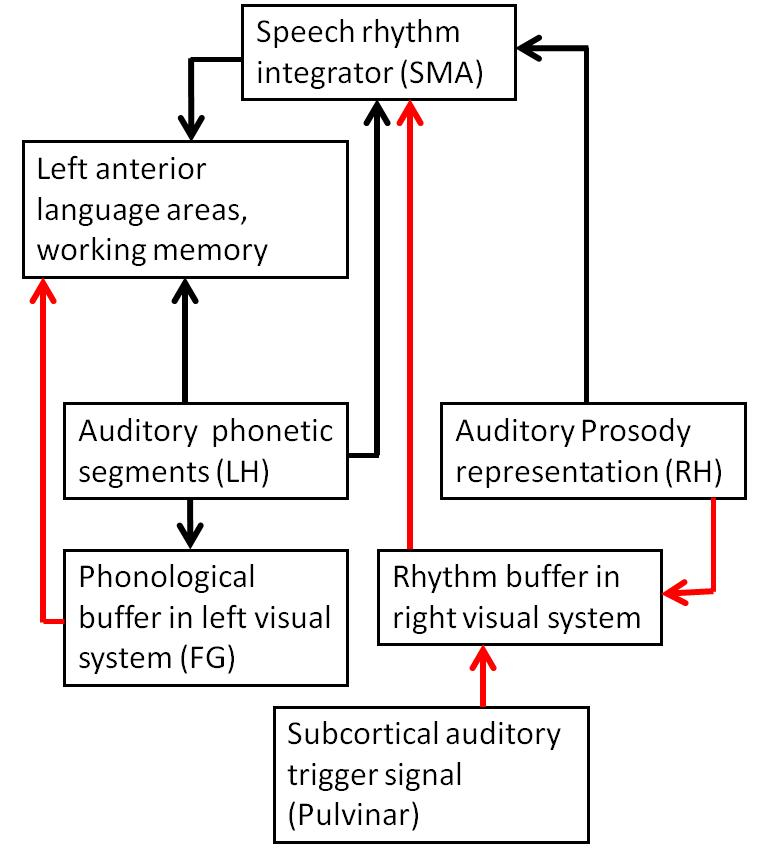
Susanne Dietrich – susanne.dietrich@med.uni-tuebingen.de
Ingo Hertrich – ingo.hertrich@uni-tuebingen.de
Hermann Ackermann – hermann.ackermann@uni-tuebingen.de
Department of General Neurology
Hertie Institute for Clinical Brain Research
University of Tübingen
Hoppe-Seyler-Str. 3, D-72076
Tübingen, Germany
Popular version of paper 2pSC6
Our research indicates that in blind listeners the capability for ultra-fast speech comprehension (16 syllables per second) covaries with hemodynamic activation of right-hemisphere primary visual area (V1), left fusiform gyrus (FG) and bilateral pulvinar. Thus, blind listeners appear able to “hijack” the visual system in order to better comprehend spoken language.
In analogy to the fast-reading skills of sighted subjects, blind people can manage - by repeated exposure to accelerated verbal utterances - to understand spoken language at enhanced speaking rates of up to 22 syllables (syl) per second – an accomplishment exceeding by far the limits of untrained subjects (ca. 8 syl / s). Blind individuals have been found to outperform sighted control subjects in tasks requiring temporal order judgements of backward-masked tone stimuli. Comprehension of ultra-fast speech means that each syllable acts as a potential masker of the preceding one. Our results suggest that blind listeners are able to extend the classical perisylvian language network to the right V1 and left FG if they trained their skills for understanding ultra-fast syllable rates.
In order to obtain a quantitative behavioral measure of an individuals’ capability to understand ultra-fast speech utterances, each subject, 14 blind and 12 sighted, participated in a sentence repetition task (determination of the percentage of correctly reproduced words). As a subsequent step of the experiment, participants were asked to listen attentively to moderately fast (8 syl / s, listen to audio1), ultra-fast (16 / s, listen to audio2), and time-reversed versions of each speaking rate using functional magnetic resonance imaging (fMRI).
Audio1. to listen to an example for the moderately fast speaking rate: “I am delighted to inform you that the paper you will be presenting at the upcoming ASA meeting in Seattle was identified as being potentially newsworthy and of interest to reporters.”
Audio2. to listen to an example for the ultra-fast speaking rate. “News organizations such as the New York Times, New Scientist, Discover, and Nature routinely cover ASA meetings, in large part due to the lay-language papers prepared by meeting speakers.”
During the ultra-fast condition, behavioral data of ultra-fast comprehension capability covaried with activation of inferior frontal gyrus (IFG), posterior superior temporal sulcus (pSTS), and supplementary motor area (SMA), as well as with right-hemisphere primary visual cortex (V1), contralateral fusiform gyrus (FG), and bilateral pulvinar (Pv) (see Figure 1). Subsequent dynamic causal modeling (DCM) revealed (i) intrinsic forward connections from left-hemisphere FG to ipsilateral IFG, and (ii) input of bilateral pulvinar and primary auditory cortex (right > left) to right V1, V1 being further connected with bilateral pSTS and left SMA.

Figure 1. Hemodynamic activation of behavioral performance as a covariate for the ultra-fast speech condition.
Presumably, FG extends the perisylvian network (i.e., IFG, pSTS) engaged in the sequencing of verbal utterances, whereas the collaboration of right-hemisphere auditory cortex and ipsilateral V1 seems to support the representation of the rhythmic syllabic structure. This information, conveyed via left SMA to the perisylvian “language zones”, can be expected to facilitate the consolidation of linguistic information, e.g., at the level of verbal working memory, under time-critical conditions. Bilateral Pv, finally, seems to contribute to the synchronization of auditory and visual cortex during ultra-fast speech perception (see Figure 2). It remains to be established, however, whether sighted subjects are also able to acquire the skill of ultra-fast speech comprehension up to the level observed in blind individuals.

Figure 2. Schematic display of the hypothesized pathways enhancing ultra-fast speech perception in blind listeners. Within the left-hemisphere, fusiform gyrus (FG) contributes to the perisylvian phonological processing network. By contrast, parts of the right-hemisphere visual system seems to be involved in timing processes by receiving cross-modal subcortical and cortical input that, via supplementary motor area (SMA), could be used to trigger working memory encoding. Red arrows were adopted from Figure 4a and mark those connections that are supposed to particularly speed up speech comprehension in blind individuals.